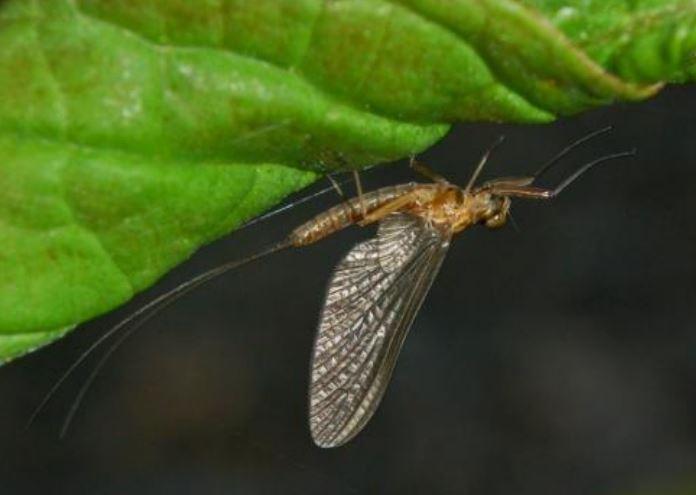Low-
Moderate
The population size of Paraleptophlebia falcula is low and the trend unknown. These mayfly species are generally rare and have very restricted distributions.
Mayflies are very sensitive to pollution, and as such are usually only found at high quality, minimally polluted sites. Mayflies are a commonly used index of water quality and aquatic ecosystem health.
Description and Range
Physical description
This species belongs to the family of prong-gilled mayflies, Leptphlebiidae. Adult mayflies are delicate and short-lived. They have large triangular-shaped front wings that typically have many veins and are held straight above the body while at rest; the hind wings are small and rounded or may be absent. They have well-developed eyes and small antennae, and their front legs are usually longest. The long abdomen ends two or three long, thread-like tails.
Ecology and life history
The genus often prefers moderate to fast streams with sand, gravel and detritus substrates.
All mayflies are aquatic in their developmental stages. Their lifespan is spent almost entirely undergoing numerous molts.
Larval existence is usually three to six months but can be as short as two weeks or as long as two years. The nymphs are generalists, moving over stones and weeds to graze off bacteria, collecting from sediments or feeding on detritus. Adults do not eat; they have nonfunctional digestive systems.
Unlike most insects, the mayfly typically has two winged stages. It is the only existing insect that molts after getting functional wings. The first stage, the subimago, is a subadult stage typically found perched on shoreline vegetation; it lasts from four minutes to 48 hours (correlated with the lifespan of the species’ adult stage). Soon after it is formed (in most species), the subimago molts to form the imago, the true adult or reproductive stage. Both subimagos and adults tend to remain along banks at emergence sites.
Mayfly eggs are eaten by snails and caddisfly larvae. The nymphs may be eaten by fish, frogs, birds, flies, or water beetles. The subimagos are eaten by fish, birds, dragonflies, water beetles, or other predatory insects.
Mating occurs in a swarm, and the eggs are laid as the female skims the water. The eggs sink to the bottom, and develop sticky substances or adhesive disks, depending on the species.
Adults of most species are short-lived (less than two hours to three days).
Mayfly dispersal is limited in the larval stage by drainage systems and in adult stages by relatively short life spans and weak flying ability of gravid females. Dispersal at the population level has been little studied. Adult dispersal ability has not been extensively studied; however, several characteristics appear to limit occurrences to a short distance, including weak flying ability, extremely short life cycle, and tendency to remain in the area of emergence. Once a population becomes established, there is little opportunity for exchange of genetic materials with populations in other drainage systems.
Geographic range
In Washington, this rare species occurs in the South Fork Walla Walla River. In Oregon, it has been reported from the South Fork Walla Walla River, Umatilla County, in Benton and Union counties, and an unrecorded location in Idaho. It is also found in Siberia and the Russian Far East.
For a map of range-wide distribution and conservation status, check out NatureServe Explorer.
Climate vulnerability
Sensitivity to climate change
Low-
Moderate
Little is known about Paraleptophlebia falcula, a species of mayfly which has been located in rivers in Washington, Oregon, and Idaho. All mayflies require aquatic habitats for nymph survival, so sensitivity likely is tied to this requirement. This species could be affected by changes in hydrology including drought, precipitation changes, and summer low flows. Mayflies tend to be sensitive to changes in streambed substrate, water temperature, and water quality as well.
Exposure to climate change
Moderate
- Increased water temperatures
- Changes in precipitation and/or drought
- Low summer flows
Conservation
Conservation Threats and Actions Needed
- Resource information collection needs
- Threat: Lack of data on current status and distribution
- Action Needed: Determine distribution and population status
- Fish and wildlife habitat loss or degradation
- Threat: Water quality is of extreme importance to aquatic insects
- Action Needed: Protect riparian habitats
- Climate and severe weather
- Threat: Drying of streams
- Action Needed: Determine distribution and population status
See the Climate vulnerability section for more information about the threats posed by climate change to this species.
Resources
References
Edmunds, G. F. and R. D. Waltz. 1996. Ephemeroptera. Pages 126-163 in R.W. Merritt and K.W. Cummins (editors). An introduction to the aquatic insects of North America. 3rd Edition. Kendall/Hunt Publishers, Dubuque, Iowa.
Edmunds, G. F., S. L. Jensen, and L. Berner. 1976. The mayflies of North and Central America. University of Minnesota Press, Minneapolis, 330 pages.
Meyer, M. D. and W. P. McCafferty. 2007. Mayflies (Ephemeroptera) of the far western United States. Part I: Washington. Transactions of the American Entomological Society, 133(1-2): 21-63.
Meyer, M.D., and W. P. McCafferty. 2007. Mayflies (Ephemeroptera) of the far western United States. Part 2: Oregon. Transactions of the American Entomological Society 133: 65-114.
NatureServe. 2014. NatureServe Explorer: An online encyclopedia of life [web application]. Version 7.1. NatureServe, Arlington, Virginia. Available http://explorer.natureserve.org.
Tiunova T. M., and N. Kluge. 2016. Redescription of Paraleptophlebia falcula Traver 1934 with notes on status and composition of Paraleptophlebia Lestage 1917 and Neoleptophlebia Kluge 1997 (Ephemeroptera: Leptophlebiidae). Zootaxa 4098:369-382.
